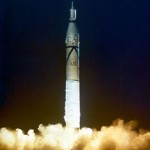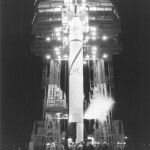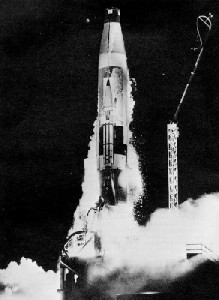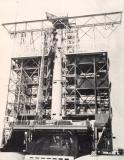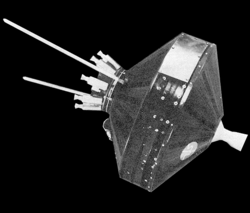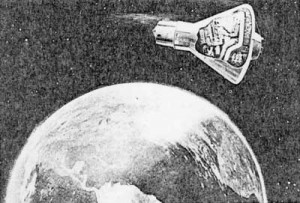 Orbital Launch Manifest 1958 (5.7 KiB)
Orbital Launch Manifest 1958 (5.7 KiB)
January 1: The Strategic Air Command was assigned responsibility for the United States operational ICBM capability.
January 10: The fourth Atlas made a successful limited flight. In 1958, thirteen ballistic launches were attempted with nine (or seven by other sources) successes.
January 28: Thor No. 11 was launched successfully but veered off course. In 1958, ten Thor ballistic launches were attempted with only five successes.
January 31: A conference was held at Wright-Patterson Air Force Base, Ohio, to review
concepts for manned orbital vehicles. The NACA informally presented two concepts then under study at Langley Aeronautical Laboratory:
– One proposed by Maxime A. Faget involved a ballistic, high-drag capsule with heat shield on which the pilot lies prone during reentry, with reentry being accomplished by reverse thrust at the apogee of the elliptical orbit involving a deceleration load of about 8g, and proceeding to impact by a parachute landing.
– Another Langley proposal called for the development of a triangular platform vehicle with a flat bottom having some lift during reentry.
At this same meeting there were several Air Force contractor presentations. These were as follows:
- Northrop, boost-glide buildup to orbital speed;
- Martin, zero-lift vehicle launched by a Titan with controlled flight estimated to be possible by mid-1961;
- McDonnell, ballistic vehicle resembling Faget’s proposal, weighing 2,400 pounds and launched by an Atlas with a Polaris second stage;
- Lockheed, a 20 degree semi apex angle cone with a hemispherical tip of 1-foot radius, pilot in sitting position facing rearward, to be launched by an Atlas-Hustler combination;
- Convair reviewed a previous proposal for a large-scale manned space station, but stated a minimum vehicle – a 1,000-pound sphere – could be launched by an Atlas within a year;
- Aeronutronics, cone-shaped vehicle with spherical tip of 1-foot radius, with man
enclosed in sphere inside vehicle and rotated to line the pilot up with accelerations, and launched by one of several two-stage vehicles;
– Republic, the Ferri sled vehicle, a 4,000 pound, triangular plan with a two-foot diameter tube running continuous around the leading and trailing edge and serving as a fuel tank for final-stage, solid-propellant rockets located in each wing tip, with a man in small compartment on top side, and with a heat-transfer ring in the front of the nose for a glide reentry of 3,600 miles per hour with pilot ejecting from capsule and parachuting down, and the launch vehicle comprising three stages;
- AVCO, a 1,500-pound vehicle sphere launched by a Titan, equipped with a stainless-steel-cloth parachute whose diameter would be controlled by compressed air bellows and which would orient the vehicle in orbit, provide deceleration for reentry, and control drag during reentry;
- Bell, reviewed proposals for boost-glide vehicles, but considered briefly a minimum vehicle, spherical in shape, weighing about 3,000 pounds;
- Goodyear, a spherical vehicle with a rearward facing tail cone and ablative surface, with flaps deflected from the cone during reentry for increased drag and control, and launched by an Atlas or a Titan plus a Vanguard second stage;
- North American, extend the X-15 program by using the X-15 with a three-stage launch vehicle to achieve a single orbit with an apogee of 400,000 feet and a perigee of 250,000, range about 500 to 600 miles and landing in the Gulf of Mexico, and the pilot ejecting and landing by parachute with the aircraft being lost.
January 31: The first American satellite, Explorer 1, was launched from LC26A under the IGY program. The launching of this and succeeding Explorer satellites was accomplished by the Army Ballistic Missile Agency and the Jet Propulsion Laboratory of the California
Institute of Technology using a Jupiter-C modified Redstone (also called Juno I) for the first stage and scaled-down Sergeants for the three upper stages. The first stage had 83,000 pounds thrust; the second stage, 733 pounds thrust; the third stage 200 pounds thrust, and the fourth stage, 67 pounds thrust. Cylindrical in shape, the satellite was 80 inches long, 6 inches in diameter, and weighed 30.8 pounds. The satellite’s initial perigee was 224 miles, its apogee 1,573 miles, its period 114.8 minutes. It was launched at an inclination to the Equator of 33.5’. The California Institute of Technology reported that initial data from Explorer I showed that cosmic radiation in its orbit did not exceed 12 times the amount on Earth and thus appeared to pose no great threat to travel in this region. In addition, no positive evidence of encounter with meteoritic particles had been found.
 Explorer 1 Chronology (68.0 KiB)
Explorer 1 Chronology (68.0 KiB)
- Juno I Explorer I
- Explorer 1
- Explorer 1 Launch
- Juno I 013158
- Explorer 1 Satellite
- Explorer1 Preparations
- Explorer 1 Launch Pad
- Explorer 1 Launch Pad 2
- Explorer 1 Launch Control
- Explorer 1 News Conference
 Explorer Spacecraft List (46.0 KiB)
Explorer Spacecraft List (46.0 KiB)
 Explorer Spacecraft List 2 (138.0 KiB)
Explorer Spacecraft List 2 (138.0 KiB)
 Launch Explorer 1 (11.8 MiB)
Launch Explorer 1 (11.8 MiB)
 Early US Space History -- America's First Satellite (3.6 MiB)
Early US Space History -- America's First Satellite (3.6 MiB)
February 5: The second trial firing of a Vanguard test satellite failed as defects in the first-stage engine control system caused the rocket to veer to the right and break in two about 60 seconds after launching from LC18A. The rocket was destroyed by the range safety officer at the Air Force Missile Test Center, Cape Canaveral. The satellite weighed 3.25 pounds, was 6.4 inches in diameter. The payload included yeast. This rocket was labeled TV-3 backup.
February 16: Airman Donald G. Farrell completed a week’s isolation in a sealed space cabin at the USAF School of Aviation Medicine, Randolph Air Force Base, in an experiment testing atmospheric equipment for space flight on a simulated trip to the Moon, and the effects of this artificial environment on man’s working ability. The small cabin was comparable in dimensions and equipment to what might go into a future spaceship. Air and liquids were recycled to simulate an actual space flight.
February 17: In a letter to Soviet Premier Nikolai A. Bulganin, President Eisenhower repeated his plea for the dedication of outer space to peaceful uses.
February: Wernher von Braun proposed Project Adam. This modest $12 million project promised to have an American in space by the end of 1959, a year sooner than the Air Force’s $100 million MISS (Man-In-Space-Soonest). The manned capsule would be launched from Cape Canaveral on a Redstone booster to an altitude of 240 km, with six minutes of weightlessness in a suborbital flight, and then splash down 250 km downrange. The US Navy would provide recovery services. Von Braun invited USAF Man High’s Simons and Kittinger to Huntsville to get the program moving. Project Adam was submitted to ARPA on May 13. Roy W Johnson, head of the Advanced Research Project Agency, told the Army that Project Adam was not considered a practical proposal for manned space flight on September 11. Hugh Dryden of NACA testified to Congress that “tossing a man up in the air and letting him come back . . . is about the same technical value as the circus stunt of shooting a young lady from a cannon. . . .”. Once NACA became NASA, a suborbital test of a manned capsule aboard a Redstone was made an integral part of Project Mercury.
March 5: Explorer II was launched from LC26A using a modified Jupiter-C IRBM (also called Juno I). It did not go into orbit because of failure of the final rocket to ignite.
March 10: A working conference in support of the Air Force “Man-in-Space Soonest” (MISS) was held at the Air Force Ballistic Missile Division in Los Angeles, California.
General Bernard Schriever stated that events were moving faster than expected. By this statement he meant that Roy Johnson, the new head of the Advanced Research Projects Agency, had asked the Air Force to report to him on its approach to putting a man in space soonest. Johnson indicated that the Air Force would be assigned the task, and the purpose of the conference was to produce a rough-draft proposal.
March 12: Five Air Force officers in a B-36 cabin began a simulated five day space flight at the Wright Air Development Center.
March 17: Vanguard I was launched at Cape Canaveral fromLC18A. The satellite was 6.4 inches in diameter and weighed 3.25 pounds. The satellite’s perigee was 409miles, its apogee 2453 miles, with a period of 134.39 minutes. It was launched at an inclination to the equator of 34.25 degrees. The launching vehicle weighed 22,600 pounds at takeoff. The first stage General Electric engine (modified Viking) had a thrust of 30,000 lbs and burned LOX and RP-1. The second stage AJ-10 Aerojet engine (modified from Aerobee) had a thrust of 8,000 pounds and burned Nitric Acid and UDMH.. The third stage Grand Central Rocket solid fuel engine had a thrust of 1440 pounds. The satellite is still in orbit, and is expected to remain there for perhaps 200 years. This rocket was labeled TV4. This was after three successful suborbital test flights and two failed attempts to reach Earth orbit. Out of 11 launch attempts to place a satellite in orbit, Vanguard was successful in only three. The second and third stages were used with the Thor and Atlas boosters as “Able”. The satellite used small solar panels for power supply (first solar powered satellite).
- Vanguard Rocket Pad
- Vanguard 1
- Vanguard 1 satellite
 Launch Of Vanguard 1 (TV-4) (16.4 MiB)
Launch Of Vanguard 1 (TV-4) (16.4 MiB)
 Launch Of Vanguard 1 (TV-4) (10.8 MiB)
Launch Of Vanguard 1 (TV-4) (10.8 MiB)
 1958 Vanguard 3rd Attempt (Universal News) (2.9 MiB)
1958 Vanguard 3rd Attempt (Universal News) (2.9 MiB)
March 18: An NACA report was published entitled, “Preliminary Studies of Manned
Satellites, Wingless Configuration, Non-Lifting,” by Maxime A. Faget, Benjamine
Garland, and James J. Buglia.
March 23: The Navy conducted its first “pop-up” launching of a full-scale Polaris vehicle from the submerged launcher at San Clemente Island.
March 24: The annual Space Medicine Branch meeting was held in Washington DC, Alfred M. Mayo, B.E. was elected President. The SMB had 160 members and 23 new members. Two panels were presented: “Man’s Progress Towards Space” was chaired by Dr. Paul Campbell and “Simulated Atmospheres in Space Operations” was chaired by Dr. Hubertus Strughold.
 Sessions On Space Medicine 1958 (21.5 KiB)
Sessions On Space Medicine 1958 (21.5 KiB) Program 1958 (292.5 KiB)
Program 1958 (292.5 KiB) Abstracts 1958 (736.3 KiB)
Abstracts 1958 (736.3 KiB)
 SMB 1958 (42.9 KiB)
SMB 1958 (42.9 KiB)
March 26: Explorer III, the third United States IGY satellite, was launched by the Army using a modified Jupiter-C rocket (Juno I) from LC5. Cylindrical in shape, it was 80 inches long, 6 inches in diameter, and weighed 31.0 pounds including a payload of 18.56 pounds. instrumentation weighing 10.83 pounds was designed to measure cosmic rays. The satellite’s initial perigee was 121 miles, its apogee 1,746 miles, and its period 115.9 minutes. It was launched at an inclination to the Equator of 33.37 degrees.
March 27: President Eisenhower gave his approval to the plans for outer space exploration announced by Secretary of Defense Neil H. McElroy. The Advanced Research Projects Agency was to undertake several space projects including the launching of earth satellites and lunar probes. The Air Force Ballistic Missile
Division was authorized by ARPA to carry out three lunar probes with a Thor-Vanguard system.
March: USAF “Man In Space Soonest” (MISS) was the subject of frequent high-level meetings, including Max Faget and Robert Gilruth (NACA – Langley), and David Simons and John Stapp (USAF). Funding was requested through ARPA. The launch vehicle was initially planned to be a Thor-Vanguard with a flourine-based booster that was later changed to an Atlas. The program was transferred over in October to NASA as Project Mercury.
April 2: President Eisenhower in a message to Congress proposed the establishment of a National Aeronautics and Space Agency into which the National Advisory Committee for Aeronautics would be absorbed.
April 23: Thor-Able test vehicle number 1 was launched at Cape Canaveral in a reentry test. The nose cone contained the mouse Mia (Mouse in Able) I. The Vanguard second stage failed to fire, and the mouse and nose cone were riot recovered.
April 27: Attempted Sputnik launch (failed).
April 29: An instrumented Vanguard satellite (TV-5) was launched from LC18A but failed to achieve orbit due to a failure of the third stage to ignite.
April 1958: Randy Lovelace chaired group to set guidelines for human factors and crew training; Crossfield served on committee, steered conception of astronaut away from passive biomedical subjects and toward test pilots as in X-15.
May 1: Scientific findings from the two Explorer satellites disclosed an unexpected band of high-intensity radiation extending from 600 miles above Earth to possibly an 8,000-mile altitude. The radiation, which was described by Dr. James A. Van Allen as “ 1,000
times as intense as could be attributed to cosmic rays,” was believed to come from ionized gas. The radiation was totally unexpected, and raised many questions about manned flight into space because of the shielding which might be required.
May 14: American scientists indicated in Washington that future Moon rockets would be sterilized to forestall any biological contamination of the Moon which would endanger later scientific studies.
May 15: Sputnik III was launched by the Soviet Union. 1nstrumentaition weighing 2,134 pounds was designed to measure atmospheric pressure and composition, concentration of positive ions, the satellite’s electrical charge and the tension of the Earth’s electrostatic field, tension of the Earth’s magnetic field, intensity of the Sun’s radiation, composition and variations of primary cosmic radiation, distribution of photons and heavy nuclei in cosmic rays, and micrometeor measurements. The satellite’s initial perigee was 135 miles, its apogee 1,167 miles, its period 106 minutes. It was launched with an inclination to the Equator of 65 degrees. Never confirmed, Soviet sources suggested a total weight in orbit of about 13,200 pounds. The carrier rocket reentered on December 3, 1958, and the satellite reentered on April 6, 1960.
May 18: A Jupiter IRBM missile fired from Cape Canaveral traveled 1,600 miles, and for the first time a full-scale nose cone was recovered intact.
May 28: Vanguard SLV-1 was launched at Cape Canaveral from LC18A. Takeoff was normal, all stages fired. Satellite was 21.5 pounds, 20 inches diameter. Instruments included meteor detectors, solar radiation measurers, and thermometers. Incorrect angle carried it 2,440 miles up, then it burned on reentry between Antigua and Africa, 5,000 miles away.
June: The Army Ballistic Missile Agency led by Dr. Von Braun proposed Project Adam (a manned suborbital launch using a Redstone booster) as an immediate way to get a man into space. It was quickly turned down on July 11 by ARPA after being criticized as a “circus stunt” by Dr. Dryden at the NACA. It eventually became a part of Project Mercury.
June 25: Briefing chart entitled CREWMAN AVAILABILITY for USAF Man In Space Soonest (MISS), showing a smooth curve with names of nine test pilots plotted according to their weights, between 150 and 200 pounds, the upper limit of a human payload that the Atlas could lift. Cancelled on 1 Aug. with announcement of Project Mercury.
|
Pilot |
Rank |
Employer |
Weight (lb) inferred |
Age |
Credentials |
|
Armstrong, Neil |
— |
NACA |
150>175 (165, 1962) |
28 |
To fly X-15 |
|
Bridgeman, Bill |
— |
Douglas |
175<<200 |
Douglas Skyrocket <M2, 1951 |
|
|
Crossfield, Scott |
— |
NAA |
150<175 |
To be first X-15 pilot |
|
|
Kincheloe, Ivan |
Capt. |
USAF |
175-200 |
30 |
Bell X-2, 126,200 ft., 1956 |
|
McKay, Jack |
— |
NACA |
200 |
36 |
To fly X-15 |
|
Rushworth, Robert |
? |
USAF |
175 |
To fly X-15 |
|
|
Walker, Bob |
? |
USAF |
150 |
To fly X-15 |
|
|
White, Alvin |
? |
USAF |
175<200 |
||
|
White, Bob |
? |
USAF |
175>200 |
To fly X-15 |
June 26: Vanguard SLV-2 was launched at Cape Canaveral from LC18A. Takeoff was normal, but the second stage cut off prematurely.
July 1: Japan made its first entry into the rocket era with the successful launching of a Kappa-6tw two-stage rocket which rose 30 miles at the Michikawa Rocket Center.
July 9: A second Thor-Able was launched at Cape Canaveral. It traveled 6,000 miles into the South Atlantic. Its mouse passenger, Mia II, was believed to be still alive when the cone reached the surface of the ocean, but after 3 days the recovery search was called off when the radio in the cone became silent. The mouse experienced 60 G and 45 minutes of weightlessness and was monitored with telemetry.
July 23: A third Thor-Able in the MIA series was launched at Cape Canaveral in another reentry test. A safe landing 6,000 miles downrange near Ascension was indicated, but the nose cone with its mouse passenger, Wickie, was not located after 2 days of searching. The last two MIA flights demonstrated a successful re-entry using ablative nosecone technology.
July 18: Werhner von Braun released a report outlining manned exploration centered around the Juno V launch vehicle (later called the Saturn 1 after 2/59). A manned lunar landing could take place in 1965-66 using 15 launches and Earth Orbit Rendezvous. He also proposed a four-man space station (1961), a 50-man space station (1967), and a Lunar Base (1973). In June 1959, Project Horizon, a 12 man military Lunar Base was proposed which would require 64 Saturn launches annually.
July 19: First test flight of the Atlas B using the stage and one half design. Weight -240,000 lbs, Thrust – 360,000 lbs., and range -3700 miles. 4 (5 by some sources) out of 10 test launches of the Atlas B failed (the last launch was on 2/4/59). On 12/18/58, it was the launch vehicle for SCORE.
 Atlas B Launch List (24.5 KiB)
Atlas B Launch List (24.5 KiB)
July 25: The Air Force awarded a contract to Rocketdyne to begin work on a one million pound thrust liquid rocket engine.
July 26: Explorer IV, the fourth United States IGY satellite, was launched by the Army using a modified Jupiter-C IRBM (also called Juno I) from LC5. Cylindrical in shape, it was 80 inches long, 6 inches in diameter, and weighed 38.4 pounds, with a payload of 25.76 pounds. The satellite had an initial perigee of 163 miles, an apogee of 1,380 miles, and a period of 110 minutes. It was launched with an inclination to the Equator of 50.13 degrees.
July 29: The President signed H.R. 12575, the National Aeronautics and Space Act of 1958, Public Law 85-568. The President requested $126 million to launch the new NASA.
July 30: By using a development model of the Mercury contour couch designed by
Maxime A. Faget and associates, Carter C. Collins withstood a 20g load on the centrifuge at Johnsville, Pennsylvania. This test proved that the reentry accelerations of manned space flight could be withstood.
August 1: Army Redstone No. 50 was successfully launched at Johnston Island in the Pacific as part of the Project Hardtack tests in which a thermonuclear bomb was tested in the upper atmosphere (48 mi altitude). The flash was visible in Honolulu, 750 miles away. Another successful launch was made 12 days later (altitude 27 miles).
August 3: The USS Nautilaus (SSN-571) reaches the North Pole while submerged.
August 15: Project Saturn was initiated by order of the Advanced Research Projects Agency, with the work assigned to the Redstone Arsenal. At this time it was called “Juno V” (later Saturn I or C-1) and the decision had been made to use eight H-1 engines (derivatives of the S-3D Thor/Jupiter engines). The Saturn rocket evolved from the idea of clustering a number of Jupiter engines around Redstone and Jupiter propellant tanks to build a large launch vehicle. These engines, whose thrust would total 1.5 million pounds (6.7 million newtons), would be mounted on a structure consisting of eight 70-inch (178-centimeter)-diameter tanks clustered around a single 105-inch (267-centimeter) Jupiter tank.
August 17: The first lunar probe attempt was launched, using Thor-Able (Pioneer 0). An explosion ripped it apart 77 seconds after launch from LC17A. It has been designed to put 40 pounds of instruments in an orbit around the Moon and to take pictures of the back-side of the Moon. In addition to the scanning devices, it contained a magnetometer, a meteorite counter, and thermometers. The voyage had been intended to take 234 clays.
 Pioneer Chronology (163.5 KiB)
Pioneer Chronology (163.5 KiB)
 Unmanned Lunar And Planetary Spacecraft (188.0 KiB)
Unmanned Lunar And Planetary Spacecraft (188.0 KiB)
August 26: It was announced that two mice at the University of Texas had been kept alive 36 days sealed in a space chamber, depending exclusively on the oxygen production of algae sealed into the same system with them.
August 27: The Soviet Union sent two dogs to an altitude of 281 miles and returned them safely. The payload of the rocket was 3,726 pounds. In addition to the biological equipment, the rocket contained cameras to study the dogs, and a variety of instruments
for geophysical purposes. The rocket was stabilized in flight, to prevent rotation. The dogs were named Belyanka and Pestraya. Aerodynamic brakes were used and the dog compartment was separated from the main rocket for parachute landing.
August 27: The Norton Sound in the South Atlantic launched a rocket which contained an atomic bomb which was exploded in space as part of a test of the physical phenomena associated with such explosions. This was Project Argus. Two more successful launches occurred over the next 9 days.
August 31: The First Colloquium on Space Law was held in connection with the I.A.F. Congress at The Hague.
September 5: Lt. Richard H. Tabor, USN, began a stay of 3 days in a pressure suit in a chamber exhausted to the equivalent of 80,000 to 100,000 feet altitude (unverified).
September 7: The British Black Knight missile was launched at Woomera, Australia to an altitude of over 300 miles. The rocket had a thrust of 16,400 pounds.
September 23: Failed launch of a Soviet Luna satellite (E-1 No. 1).
September 24: The first Polaris test vehicle approximating the Polaris missile configuration was launched at Cape Canaveral but had to be destroyed shortly after takeoff when it appeared to take a wrong heading. Two other attempts on October 15 and December 30 were also unsuccessful.
September 26: Vanguard SLV-3 was launched at Cape Canaveral from LC18A. Takeoff was normal, and all stages fired. A slight failure to attain desired speed may have carried it into an orbit around the world for at least one pass where it burned on reentry
October 1: NASA was activated, and the NACA was abolished at the close of business on September 30, with all personnel and facilities transferred to the new agency. At the same time, major control of space activities in the Department of Defense was transferred to NASA. Project Vanguard personnel were also transferred to NASA.
October 4: Vandenberg Air Force Base was dedicated.
October 7: The National Aeronautics and Space Administration formally organized a project to orbit and recover a manned capsule (Project Mercury).
October 7: Space Task Group was organized at Langley Research Center, Norfolk, Va., under the leadership of Dr. Robert Gilruth.
October 11: Failed launch of a Soviet Luna satellite (E-1 No. 2).
October 11: Pioneer I was launched by the United States from Cape Canaveral, at 3:42 a.m. The launching was accomplished using a Thor-Able rocket combination from LC 17A. It reached a record altitude of about 70,700 miles and telemetered to Earth data on radiation encountered in outer space, micrometeors, temperatures, and the Earths magnetic field. The launching vehicle was a 4-stage rocket weighing approximately 112,000 pounds with a total length of 88.1 feet. A velocity of 35,250 feet per second (24,015 miles per hour) had been planned. However, because the Pioneer I traveled about 3.5’ above the designed flight path, the actual velocity attained was about 34,400 feet per second (23,447 miles per hour). The toroidial-shaped payload, pierced by the terminal-stage rocket, was 29 inches in diameter and weighed 84.4 pounds. The weight of the instrument package itself was approximately 39 pounds, and included a Navy infrared camera to photograph the Moon. Attempts to modify its flight path into a permanent eccentric orbit around the Earth failed because a retro-rocket could not be fired following a battery failure.
October 23: Failed attempt to launch Beacon (12 ft inflatable passive communications satellite) on a modified Jupiter C (Juno I) from LC5.
October 27: A special NASA Committee on Life Sciences was established at Langley to determine qualifications and attributes required of personnel to be selected for America’s
first manned space flight and to give advice on other human aspects of the manned satellite program. Dr. W. Randolph Lovelace II was appointed as Chairman.
October: The Air Force awarded contracts for the development of the Centaur high-performance upper stage.
October: Lovelace (Crossfield) committee guidelines for human factors and crew training issued final report; called for potential crew members to be checked out in ground simulators, centrifuges, balloon capsules, “and finally in supersonic aircraft such as a two-place X-15.”
November 3: Space Task Group assigned the task of selecting the first humans to fly in space to Charles Donlan, Assistant Director, Project Mercury, Allen O. Gamble, and Warren North, former NACA test pilot. Additional personnel assigned (soon thereafter, date unclear): Stanley White, M.D., USAF flight surgeon; William Augerson, M.D., U.S. Army flight surgeon; and Robert Voas, Ph.D., U.S.N. psychologist. The six individuals (Donlan, North, Gamble, White, Augerson and Voas) worked continuously full-time on astronaut selection. Others—including a high-level Special Committee on Life Sciences, appointed in late November—worked with them as needed.
November 6: The Army completed the test program for the Redstone with a successful 250-mile shot.
November 8: Pioneer II was launched from Cape Canaveral in another cis lunar attempt by a Thor-Able from LC17A. The third stage failed to ignite and it reached an altitude of only 963 miles. The failure seems to have been caused by a broken wire. The probe weighed 86.4 pounds including 34.3 pounds of instruments. Data concerning the Van Allen radiation belts was obtained.
November 10-12: The “Second International Symposium on the Physics and Medicine of the Upper Atmosphere and Space” was held by the School of Aerospace Medicine in San Antonio. It was sponsored by Dr. Otis Benson and Dr. Hubertus Strughold. The presentations were later published as a book.
 Symposium Program (62.9 KiB)
Symposium Program (62.9 KiB)
November 26: The name Project Mercury was officially assigned to the man-in-space effort of the United States.
November 38: An Atlas missile was shot over the full range for the first time, a distance of 6,325 miles from Cape Canaveral, into the South Atlantic to within 30 miles of the predicted point of impact.
December 4: Failed launch of a Soviet Luna satellite (E-1 No. 3).
December 6: Pioneer III was launched from Cape Canaveral, Fla., at 12:46 a.m. eastern standard time from LC5. The launch vehicle consisted of a modified Jupiter IRBM, Juno II. The 12 pound spacecraft was instrumented to provide information on the Van Allen radiation zone. Although the probe did not achieve its maximum objective, the environs of the Moon and beyond to a heliocentric orbit, its altitude of about 63,580 statute miles above the surface of the Earth enabled it to obtain valuable scientific data through measurements of the Van Allen radiation zone. The probe reentered the atmosphere and disintegrated. The reason the speed reached 24,000 miles per hour instead of 24,955 was the premature cut-off of fuel in the first stage, 3 seconds too soon.
 Juno II Launch List (33.5 KiB)
Juno II Launch List (33.5 KiB)
- Juno II 2
- Juno II 120658
- Pioneer 3 Satellite
- Pioneer 3 Satellite
- Juno II
December 9: An aeromedical selection team composed of Major Stanley C. White, Air Force; Lt. Robert B. Voas, Navy; and Captain William Augerson, Army, drafted a
tentative astronaut selection procedure. According to the plan, representatives from the services and industry would nominate 150 men by January 21, 1959; 36 of these would be selected for further testing which would reduce the group to 12; and in a 9-month training period, a hard core of 6 men would remain. At the end of December 1958, this plan was rejected.
December 13: The Army launched a Jupiter missile at Cape Canaveral which climbed 300 miles and traveled 1500 miles downrange. On board was a Navy-trained squirrel monkey, Gordo, or Old Reliable, whose physiological reactions were telemetered. The monkey made the trip without untoward effects, including 8.3 minutes of weightlessness, experiencing 10 g during launch and 40 g during reentry at 10,000 miles per hour. Unfortunately a leak developed in the nose cone allowing the float mechanism to fail so that the equipment, including the monkey, all sank before rescue could be effected.
December 16: The first Thor launching at Vandenberg Air Force Base went as scheduled (first launch from VAFB) 1,500 miles out the Pacific Missile Range to open use of the new facility. Launch site is now called Space Launch Complex 10. The same day a shot with similar results were obtained at Cape Canaveral with another Thor.
 Vandenberg AFB Launch History (1.3 MiB)
Vandenberg AFB Launch History (1.3 MiB)
December 17: NASA publicly announced Project Mercury as the man-in-space goal.
Project Mercury-A Chronology-NASA SP-4001.pdf
Project Mercury – P1.mp4
Project Mercury – P2.mp4
Project Mercury – P3.mp4
1958 Project Mercury.mp4
December 17: Rocketdyne of North American was awarded by NASA a contract to build a single chamber liquid-rocket engine of up to 1.5 million pounds of thrust (the F-1).
December 18: The United States Air Force with the Advanced Research Projects Agency at Cape Canaveral launched the entire rocket casing of Atlas missile 10B from LC11. With a launch weight of 244,000 pounds, approximately 8750 pounds reached orbit. Payload was only 150 pounds. Given the name Project Score, this satellite carried out active real time and delayed signal repetition of voice and Morse messages from one ground station to another. The experiment also tested the missile itself including a new inertial guidance system. Launched with a thrust of 360,000 pounds, its orbit was inclined 32 degrees to the Equator, had an apogee of 928 miles and a perigee of 114 miles.
December 19: The Atlas Project Score satellite transmitted the voice of President Eisenhower from outer space with a Christmas message to the world.
December 20: The first attempt to launch a Titan I at Cape Canaveral resulted in an explosion on the pad. See 2/6/59 for Titan I details.
 Titan Rocket Crashes (10.3 MiB)
Titan Rocket Crashes (10.3 MiB)
December 24: First test flight of the Atlas C. Specifications were similar to the Atlas B, but range was increased to 4900 miles. 3 out of 6 launches failed (the last launch was on 8/24/59.
 Atlas C Launch List (20.0 KiB)
Atlas C Launch List (20.0 KiB)
December 27: Dr. James Van Allen announced the findings of data obtained from the Pioneer and Explorer satellites showing that the Earth is surrounded by two large belts of radiation.
December 22: An invitation was sent out by NASA soliciting applications for Astronaut Researcher Candidates (NASA Project A).
 Invite (273.9 KiB)
Invite (273.9 KiB)
Late December: After a recommendation by Glennan and Dryden (and Gilruth, not present), Eisenhower decided that the first American astronauts would be selected from the ranks of military test pilots: they were accustomed to risk, already had security clearance, and were accustomed to military discipline.
Journal of Aviation Medicine articles:
Ward, J E. Requirements for experimental zero gravity parabolas.
 29060428-1 (141.9 KiB)
29060428-1 (141.9 KiB)
Kousnetzov, A G. Some results of biological experiments in rockets and Sputnik II
 29110781-1 (107.9 KiB)
29110781-1 (107.9 KiB)
Simons, D G, Archibald, E R. Selection of a sealed cabin atmosphere.
 29001 (193.7 KiB)
29001 (193.7 KiB)
von Beckh, H J. Multi-directional G protection in space flight and during escape.
 29050335-1 (205.4 KiB)
29050335-1 (205.4 KiB)
White, M S. Aeromedical realities of space travel. JAM 1958 29: 707-715.
 29100707-1 (643.8 KiB)
29100707-1 (643.8 KiB)
Knight, LA. An Approach to the Physiologic Simulation of the Null-gravity State.
 29040283-1 (96.5 KiB)
29040283-1 (96.5 KiB)
Campbell, P A. Aviation medicine on the threshold of space: Achievements of the past year. JAM 1958 29: 485-492.
 29070485-1 (497.5 KiB)
29070485-1 (497.5 KiB)
Schaefer, HJ. New Knowledge of the Extra-Atmospheric Radiation Field.
 29070492-1 (234.8 KiB)
29070492-1 (234.8 KiB)
Beischer, DE. Potentialities and Ramifications of Life Under Extreme Environmental Conditions.
 29070500-1 (81.2 KiB)
29070500-1 (81.2 KiB)
Gerathewohl, SJ, Stallings, HD. Experiments During Weightlessness: A Study of the Oculo-Agravie Illusion.
 29070504-1 (631.5 KiB)
29070504-1 (631.5 KiB)
Berry CA. The Role of Physical Standards in Jet and Rocket Aircraft Flight.
 29090631-1 (209.9 KiB)
29090631-1 (209.9 KiB)



